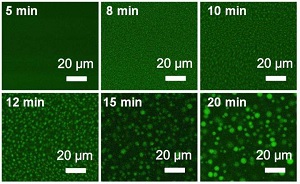 |
| Liquid droplets as bright fluorescent spots self-assemble--Courtesy of Harvard |
Materials scientists are once again looking to nature to solve a drug delivery problem. This time, researchers from Harvard have investigated the way in which living tissues bring liquids where they're needed and ultimately secrete them--and they developed a synthetic system that mimics the process.
Published this week in the journal Nature Materials, the study shows that liquid droplets can self-assemble in a polymer gel with a thin layer of liquid on its surface. The liquid can then spontaneously release itself from the gel, but only insofar as it is replacing what is lost from the surface. So the liquid essentially "sweats" from its vehicle as opposed to releasing all at once.
"Current fluid secretion technologies are generally designed with one-time only release mechanisms. Once the fluid is released, it continues flowing, at a consistent pace, until the supply is exhausted, regardless of the needs of its surroundings," lead researcher Joanna Aizenberg said in a statement as reported by Phys.org. "These kinds of triggered releases aren't responsive to the consumption of fluid. Our system ties fluid secretion to fluid consumption and controls for when and how much liquid is secreted at a time."
What this offers is a self-healing polymer that can fill in cracks on its surface by secreting liquid there. And in a drug delivery context, the vehicles could deliver potent cancer cocktails in a controlled, targeted manner.
"For years, material scientists created static materials and then tried to figure out how to get them to change as an afterthought," Aizenberg said. "Now, the direction of material science is to look at nature and recognize that nature has already invented sophisticated responsive, dynamical material systems, and we can take inspiration from that."
- here's the Phys.org story
- here's the abstract